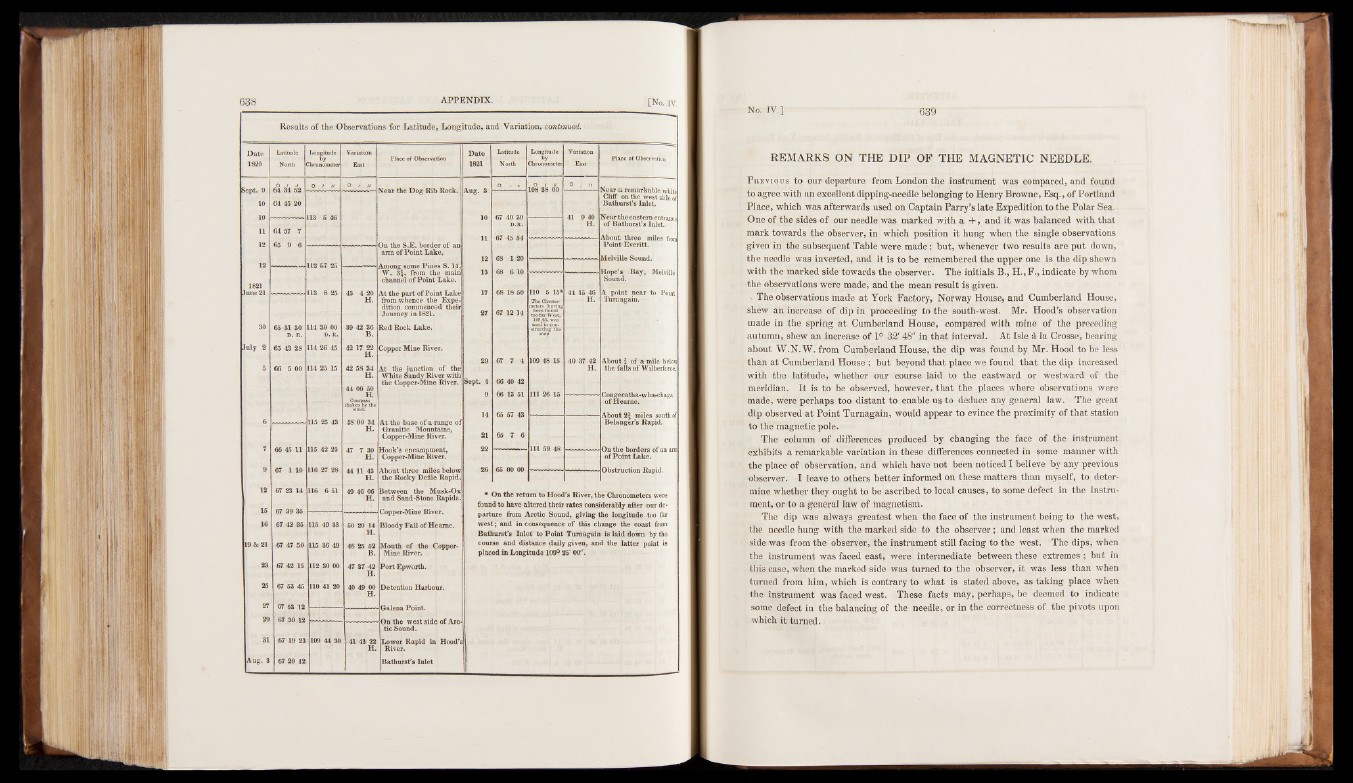
Results of the Observations for Latitude, Longitude, and Variation, continued.
Date Latitude Longitude Variation Date Latitude Longitude Variation 1820 North Chronometer East 1821 North Chronometer East Place of Observation
SL epj . 1 64 34 52 o / > q / ,./ƒ •Neal't e Dog Rib Roc . Aug. 3 o. .« * 108 38 00 © ) VI/ 10 64 45 20 Cliff on the west side of
3 G 40
Bathurst’s Inlet.
D.R. H. Noefa Br aththeu erasstt’esr Inn elnettr.ance 11 64 57 7 «T RA About three miles from 12 65 9 6 In the S.E. border of an 07 4j </4 Point Everitt.
12 119 (VT 9<5 e P'n*'? ^ 14 12 G8 1 20
W. 3j, from the main 68 6 10 HSoopuen’sd . Bay, Melville Ju1n8e2 12 1 113 8 25 43 4 20 At the part of Point Lake 17 68 18 50 110 5 15* 44 15 46 A point near to Point H. fdriotimon w hcoemncme etnhcee dE txhpeeir- H. Turnagain. Journey in 1821. 27 67 12 14
30 65 31 30 [14 30 00 39 42 36 [led Rock Lake. 1 D. R. D. R. B. map
July 2 65 43 28 114 26 45 42 17 H22. Copper Mine River.
5 66 5 00 L14 25 15 42 58 34 At the junction of the 29 67 7 4 109 48 15 40 37 H42. Atbhoe ufta l|l so off aW milbieler fobrelcoew. H. Wtheh iCteo pSpaenrd-My Riniev eRri vweirt.h Sept. 4 66 40 42 44 00 50 9 fifi 1* K1 111 26 15 Con icatha h h ÄsL ofIkearae.
115 25 43 48 00 34 At the base of a range of 14 65 57 43 ABbe lan12ge1r 's *R1 apid. th f H. CGorpapneitri-cM iMneo Runivtaeirn.s, 21 65 7 6
„ ,, 22 O th b J f H. Copper-Mine River. of Point Lake.
116 27 28 44 11 H43. Atbhoe uRt otchkryee D mefiillees R baeploidw. 26 65 00 00 ObI tI It ’I jlRl ld '
12 67 23 14 116 6 51 49 46 H06. Baentdw eSeann d-tShteo nMe Ruaskp-iOdsx. • Dn the return to Hood’s River, the Chronometers were
15 67 39 35 Copper-Mine River. fpoaurntudr teo fhraovme aAltrecrteicd Sthoeuirn dra, tgeisv cinongs tihdee ralobnlyg iatuftdeer otouor dfaer-
16 67 42 35 115 49 33 50 20 H14. Bloody Fall of Heame. west; and in consequence of this change the coast from Bathurst’s Inlet to Point Turnagain is laid down by the
19 & 21 67 47 50 115 36 49 46 25 52 course and distance daily given, and the latter point is
B. Mine River. . placed in Longitude 109° 25' 00".
23 67 42 IS 112 30 00 47 37 42 H. Port Epworth.
25 67 53 45 110 41 20 40 49 H00. Detention Harbour.
27 67 53 12 Galena Point.
29 67 30 12 On the west side of Arc- tic Sound.
31 67 19 23 109 44 30 41 43 H22. LRoiwveerr .Rapid in Hood’s
|Aog. S 67 20 12 Bathurst’s Inlet
REMARKS ON THE DIP OF THE MAGNETIC NEEDLE.
Previous to our departure from London the instrument was compared, and found
to agree.with an excellent dipping-needle belonging to Henry Browne, Esq., of Portland
Place, which was afterwards used on Captain Parry’s late Expedition to the Polar Sea.
One of the sides of our needle was marked with a + , and it was balanced with that
mark towards the observer, in which position it hung when the single observations
given in the subsequent Table were made; but, whenever two results are put down,
the needle was inverted, and it is to be remembered the upper one is the dip shewn
with the marked side towards the observer. The initials B., H., F., indicate by whom
the observations were made, and the mean result is given.
n The observations made at York Factory, Norway House, and Cumberland House,
shew an increase of dip in proceeding to the south-west. Mr. Hood’s observation
made in the spring at Cumberland House, compared with mine of the preceding
autumn, shew an increase of 1° 32' 48" in that interval. At Isle & la Crosse, bearing
about W.N.W. from Cumberland House, the dip was found by Mr. Hood to be less
than at Cumberland House ; but beyond that place we found that the dip increased
with the latitude, whether our course laid to the eastward or westward of the
meridian. It is to be observed, however, that the places where observations were
made, were perhaps too distant to enable us to deduce any general law. The great
dip observed at Point Turnagain, would appear to evince the proximity of that station
to the magnetic pole. '
The column of differences produced by changing the face of the instrument
exhibits a remarkable variation in these differences connected in some manner with
the place of observation, and which have not been noticed I believe by any previous
observer. I leave to others better informed on these matters than myself, to determine
whether they ought to be ascribed to local causes, to some defect in the instrument,
or to a general law of magnetism.
The dip was always greatest when the face of the instrument being to the west,
the needle hung with the marked side to the observer; and least when the marked
side was from the observer, the instrument still facing to the west. The dips, when
the instrument was faced east, were intermediate between these extremes ; but in
this case, when the marked side was turned to the observer, it was less than when
turned from him, which is contrary to what is stated above, as taking place when
the instrument was faced west. These facts may, perhaps, be deemed to indicate
some defect in the balancing of the needle, or in the correctness of the pivots upon
which it turned.